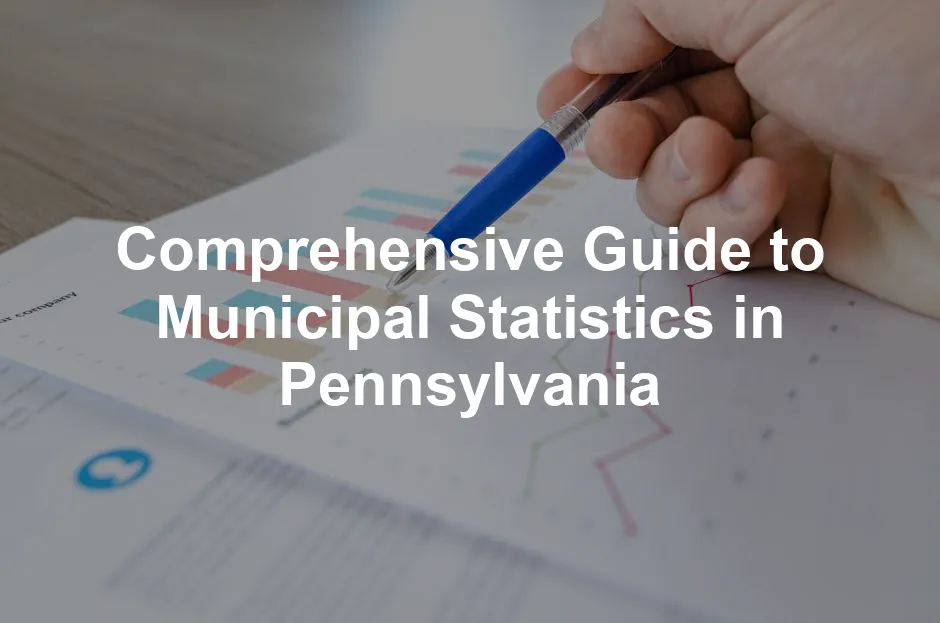Introduction
Municipal statistics in Pennsylvania play a vital role in shaping communities. They provide a treasure trove of data that local governments, residents, and businesses rely on. Think of it as a roadmap for decision-making and planning—without it, we’d be lost!
These statistics cover various aspects of municipal life. Tax rates shine a light on the financial obligations of residents and businesses. Demographic data reveals who lives in the area and their needs. Financial reports present a snapshot of a municipality’s economic health and priorities.
Accurate and up-to-date data is crucial. It ensures that local governments can make informed decisions. From budget allocations to infrastructure projects, everything hinges on reliable statistics. When communities have access to this information, they can plan better and respond to challenges more effectively.
In a nutshell, municipal statistics are the backbone of informed governance, empowering residents and officials alike. They foster transparency, accountability, and progress. So, let’s get to know what these statistics entail and why they matter!

Understanding Municipal Statistics
Definition of Municipal Statistics
Municipal statistics refer to a collection of data that encompasses various aspects of local governance. This includes information on demographics, finances, and services provided by a municipality. They are essential for effective local governance, allowing officials to analyze trends, allocate resources, and assess community needs.
In Pennsylvania, the Pennsylvania Department of Community and Economic Development (DCED) is the go-to source for these statistics. They collect and disseminate data to ensure communities have access to the information they need. This includes detailed reports on tax rates, population estimates, and municipal financial health.
Speaking of detailed reports, if you’re looking for a comprehensive dive into local governance, check out the Local Government Handbook. This book is like having a cheat sheet for local governance, packed with insights that can help you understand the ins and outs of municipal operations!

Importance of Municipal Statistics
Municipal statistics are significant for a variety of stakeholders. For residents, they provide insight into local tax rates and services. Knowing how much tax they pay helps residents understand their contributions to community services. Local businesses benefit too, as they can gauge market opportunities based on demographic trends.
For government officials, these statistics guide decision-making. They help identify areas needing improvement and inform policy development. For example, if data shows a surge in population, a municipality might decide to invest in more schools or public services.
Take the classic case of a town experiencing rapid growth. Without accurate data, officials might not realize they need additional resources. When they have access to updated demographic statistics, they can plan effectively, ensuring the community continues to thrive.
In essence, municipal statistics are not just numbers; they are the foundation upon which vibrant communities are built. They’re pivotal in driving local policies and fostering growth, ensuring that every resident’s needs are met.

Types of Municipal Statistics in Pennsylvania
Understanding the types of municipal statistics in Pennsylvania is crucial for residents, businesses, and local governments. These statistics provide vital insights into tax obligations, community demographics, and financial health. Let’s break down the key categories.
Tax Information
Municipal Tax Rates
Taxes are like the broccoli of local governance; nobody loves them, but we all need them! In Pennsylvania, various municipal taxes impact residents and businesses alike. The Earned Income Tax (EIT) is commonly imposed on wages, while the Local Services Tax (LST) affects those working within a municipality.
The EIT is typically set at a rate of 1% to 3%, depending on the municipality. This tax funds essential services like police and fire departments. The LST, on the other hand, is usually a flat fee, often around $52, aimed at funding local services.
Understanding these taxes helps residents plan their budgets. For businesses, knowing the local tax landscape can influence decisions like where to establish operations. If you’re in a municipality with a high EIT, it might make you rethink that downtown office space!
If you want to dive deeper into budgeting strategies, consider picking up a copy of the Local Government Budgeting Guide. This guide can help municipalities navigate the tricky waters of financial planning and resource allocation!

Tax Registers
Tax registers are the unsung heroes of municipal finance. They provide access to detailed tax information and are essential for transparency. These registers offer insights into the EIT, LST, and other local taxes, allowing residents to understand their tax liabilities fully.
Accessing tax registers can be done online, where municipalities maintain real-time data. This feature is a game-changer! Residents can check their tax obligations without hefty trips to city hall. It’s like having a personal tax assistant, minus the awkward small talk.

Demographic Information
Demographic statistics are crucial for community planning, and Pennsylvania municipalities offer a wealth of data. This includes population estimates, employment figures, and socioeconomic indicators.
For example, if a municipality sees a population surge, it might need to improve local schools or public transportation. Employment figures can indicate economic vitality or distress, prompting local leaders to act.
Consider this: a municipality with a growing number of young families might prioritize parks and recreational facilities. Conversely, areas with an aging population may focus on healthcare services. Demographic data helps municipalities tailor their services to meet community needs effectively.
If you’re interested in understanding the broader context of demographic changes, check out Demographic Change and Local Governance. This book provides insights that can help you understand how demographic shifts impact local policies.

Financial Reports
Financial reports offer a snapshot of a municipality’s fiscal health. They include vital information on revenue, expenses, and budget allocations. This data is essential for understanding how well a municipality is managing its finances.
One critical aspect is the Municipal Liquid Fuels Program. This program allocates funds for maintaining and improving local roads. Municipalities receive allocations based on their population and the miles of roads they maintain. It’s a lifeline for local infrastructure, ensuring that potholes don’t become the next tourist attraction!
Regular financial reports help local governments make informed decisions. By analyzing revenue trends, they can adjust budgets to respond to economic shifts. A well-documented financial health leads to better planning and resource allocation, ultimately benefiting the community.
If you’re keen on learning more about financial management, consider the Municipal Financial Management Book. It’s an excellent resource for understanding the intricacies of managing municipal finances!

In conclusion, the types of municipal statistics in Pennsylvania are diverse and impactful. From tax information to demographic insights and financial health, these statistics serve as a foundation for effective governance. Whether you’re a resident, business owner, or local official, understanding these statistics can help foster a vibrant and responsive community.

How to Access Municipal Statistics
Online Resources
Accessing municipal statistics in Pennsylvania is like finding the golden ticket to your local governance! The Pennsylvania Department of Community and Economic Development (DCED) makes it a breeze. Here’s a step-by-step guide to unlocking a treasure trove of data:
1. Visit the DCED Website: Head over to the DCED Municipal Statistics page. This is your gateway to vital information.
2. Find Your Municipality: On the homepage, look for the “Find Municipality by Address” section. Here, you can input your street address, city, and zip code. It’s like a magic search box, leading you straight to your municipality’s data.
3. Review Tax Information: After submitting your address, you’ll receive information about your municipality, including local tax rates. This data is essential for understanding your financial obligations!
4. Explore Financial Reports: Navigate to the “Financials” section on the site. Here, you’ll find annual financial reports that detail your municipality’s revenue and expenses. Think of it as peeking into the local wallet!
5. Check Demographic Data: Don’t miss the “Demographic Information” section. This includes population estimates and socioeconomic data, giving you insight into the community’s makeup.
6. Stay Updated: Remember, the data refreshes nightly, so check back often for the latest information. Accurate data is like a well-tuned engine; it keeps everything running smoothly!
7. Contact Information: If you have questions, don’t hesitate to reach out. The DCED provides contact details, including a phone number (888-223-6837) and email (RA-munistats@pa.gov). Sometimes, a friendly voice is all you need!

Navigating the Municipal Statistics Portal
Once you’re on the municipal statistics portal, navigating it is straightforward. Here’s how to make the most of it:
– Search by Address: Use the search function to find specific municipality data by entering your address. This feature is particularly useful if you’re curious about tax rates or demographic information specific to your location.
– Utilize Filters: Take advantage of any filters available to narrow down your search results. This can save you time and help you find exactly what you’re looking for.
– Verify Information: Always keep your contact information updated in the system. This ensures you receive the most accurate and relevant data for your municipality. After all, nothing is worse than being left in the dark about local statistics!
– Bookmark Useful Links: As you discover valuable resources, bookmark them for easy access later. This way, you won’t have to search again next time you need to check your local statistics.
By following these steps, you’ll become a pro at accessing municipal statistics in Pennsylvania. With a bit of curiosity and a few clicks, you’ll be equipped with the knowledge to make informed decisions about your community!

Challenges in Municipal Statistics
Data Accuracy and Reliability
When it comes to municipal statistics, accuracy is key. However, there are challenges to consider. Self-reporting by municipalities can lead to discrepancies in data. Picture this: a municipality may underreport its population or financial obligations. This could skew the data, leading to poor decision-making down the line.
For example, if a town claims it has fewer residents than it actually does, state funding could be impacted. It’s crucial that decision-makers have reliable data to ensure resources are allocated fairly.
To combat this issue, it’s essential to verify information with local officials. Don’t just take the numbers at face value! A quick phone call or email can clarify any doubts and ensure you’re working with the most accurate data available.
In addition, the importance of community engagement cannot be overstated. Residents should feel empowered to question and verify the data reported by their local officials. After all, it’s their community at stake!
So, as you navigate the world of municipal statistics, remember: vigilance is your best ally. Stay informed, ask questions, and ensure that the statistics driving decisions in your community are as accurate as possible.

Data Accessibility
Accessing municipal statistics can feel like trying to find a needle in a haystack for some residents. The digital landscape isn’t always friendly, especially for those who aren’t tech-savvy. Websites can be cluttered, confusing, or simply hard to navigate. Not to mention, some important data might be buried deep within the labyrinth of municipal portals.
But fear not! There are ways to tackle these challenges. One solution is to organize community workshops. Imagine a gathering where local officials guide residents through the online resources. Participants could learn to navigate the municipal statistics portal, understand tax registers, and discover financial reports—all in a friendly, supportive environment.
Additionally, online tutorials could be a game-changer! Short, engaging videos can break down the steps for accessing vital data. These resources can empower residents to take charge of their local statistics. With a little help, everyone can become a statistics whiz!
For those who want to delve deeper into learning about statistical software, consider Statistical Software for Beginners. It’s a great resource for those looking to get a handle on data analysis!

Case Studies: Impacts of Municipal Statistics
Successful Implementation of Data-Driven Policies
Let’s take a stroll through Pennsylvania and explore how some municipalities have effectively harnessed statistical data for positive change. Take West Chester, for example. This charming borough utilized demographic data to identify a growing population of young families. The result? A surge in investments in parks and recreational facilities. This initiative not only enhanced the quality of life but also attracted new residents. Talk about a win-win!
Then there’s Allentown, which faced challenges in public safety. By analyzing crime statistics, officials pinpointed hotspots and allocated resources accordingly. They increased patrols in high-crime areas, resulting in a significant drop in incidents. Data-driven decisions led to safer streets and a more secure community.
Another success story comes from Pittsburgh. The city used financial reports to assess its infrastructure needs. By prioritizing projects based on data, they secured funding for essential repairs, improving road conditions significantly. Residents are now navigating smoother streets. Data isn’t just numbers; it’s the catalyst for transformation!
If you want to understand the principles behind effective urban planning, check out Urban Planning: Theory and Practice. This book offers insights into how data shapes urban development!

Lessons Learned from Data Misuse
However, it hasn’t always been sunshine and rainbows. Some municipalities in Pennsylvania have learned the hard way that misuse of data can lead to dire consequences. Let’s look at a case involving a small town that misreported population figures. The inaccurate data led to inadequate funding from the state. The town’s budget was strained, and essential services were compromised. Residents felt the pinch, and trust in local governance waned.
Another example is a borough that misinterpreted financial data. Instead of recognizing a trend of declining revenue, they continued spending as if their coffers were full. Eventually, they faced financial turmoil, forcing painful cuts to services. The lesson here? Accurate reporting and interpretation are crucial for sound decision-making.
To improve future practices, municipalities must prioritize data accuracy. Regular training sessions for officials and staff can ensure they understand how to collect and report data correctly. Transparency and community engagement should also be emphasized. Residents need to know the numbers driving their local policies. By fostering a culture of accountability, municipalities can avoid the pitfalls of data misuse.
In conclusion, while there are challenges in accessing and interpreting municipal statistics, there are ample opportunities for improvement. By learning from both successes and failures, Pennsylvania municipalities can create a better future for their residents. With the right tools and practices, data can illuminate the path toward thriving communities!

Conclusion
Municipal statistics serve as the backbone of effective local governance and community engagement in Pennsylvania. They provide essential insights that help local officials make informed decisions. In a world where data reigns supreme, having accurate and timely statistics is more crucial than ever.
These statistics encompass a variety of information, from tax rates to demographic trends. When local governments have access to this data, they can identify community needs and allocate resources effectively. This level of transparency fosters trust between officials and residents, paving the way for collaborative problem-solving.
Ongoing data collection is not just a nice-to-have; it’s a necessity. The landscape of communities is always shifting, and keeping data up to date ensures that local policies reflect current realities. Accurate information helps prevent disasters like budget shortfalls or inadequate public services. After all, nobody wants to be the town that forgot to count its residents!
Accessibility is equally important. If residents can easily find and understand municipal statistics, they are empowered to engage with local officials. This engagement can lead to meaningful discussions about community needs and priorities. Residents should feel encouraged to ask questions and demand clarity on the data that affects their lives.
So, here’s a friendly nudge: take the time to engage with your local officials. Utilize resources available through the Pennsylvania Department of Community and Economic Development (DCED) and other local platforms. Knowledge is power, and understanding municipal statistics can help you advocate for your community’s needs.
In essence, municipal statistics are not mere numbers. They are tools that can drive community engagement and effective governance. By prioritizing data collection, accuracy, and accessibility, we can build stronger, more vibrant communities that serve everyone.

FAQs
What are municipal statistics?
Municipal statistics are a collection of data that provide insights into various aspects of local governance. They include information on tax rates, population demographics, financial reports, and service delivery. For instance, municipal statistics may show the local earned income tax rates or the number of residents in a town. This information is vital for understanding community needs and planning effectively.
How can I find my local tax rates?
Finding your local tax rates is easier than pie! Simply visit the DCED website. You can enter your address to find the specific municipality and school district associated with it. This search will yield detailed information on local tax rates, including the Earned Income Tax (EIT) and Local Services Tax (LST). It’s the one-stop-shop for all your local tax queries.
Why is it important to have current municipal statistics?
Up-to-date municipal statistics are crucial for both residents and local governments. They enable informed decision-making, helping officials allocate resources appropriately. For residents, current statistics provide insights into local taxes and services. Understanding these figures can empower residents to advocate for their community’s needs effectively. Without accurate data, communities risk becoming misaligned with the needs of their residents.
What should I do if I find discrepancies in municipal data?
If you encounter discrepancies in municipal data, don’t just sit there! Report your findings to your local government officials or the DCED. Provide them with details about the inconsistency. It’s essential to address these issues, as they can impact funding and services for your community. Transparency is key, and your voice can help ensure that data is accurate and reliable.
Where can I get assistance for understanding municipal statistics?
If you need help navigating municipal statistics, you have several resources at your fingertips! The DCED offers support and guidance. You can reach out to their office via phone at 888-223-6837 or email at RA-munistats@pa.gov. Additionally, local government officials can assist you in understanding how municipal statistics affect your community. Don’t hesitate to ask questions—after all, informed residents make for thriving communities!
For those looking to dive deeper into the world of municipal statistics, you can explore more about municipal statistics in Pennsylvania.
Please let us know what you think about our content by leaving a comment down below!
Thank you for reading till here 🙂
All images from Pexels




